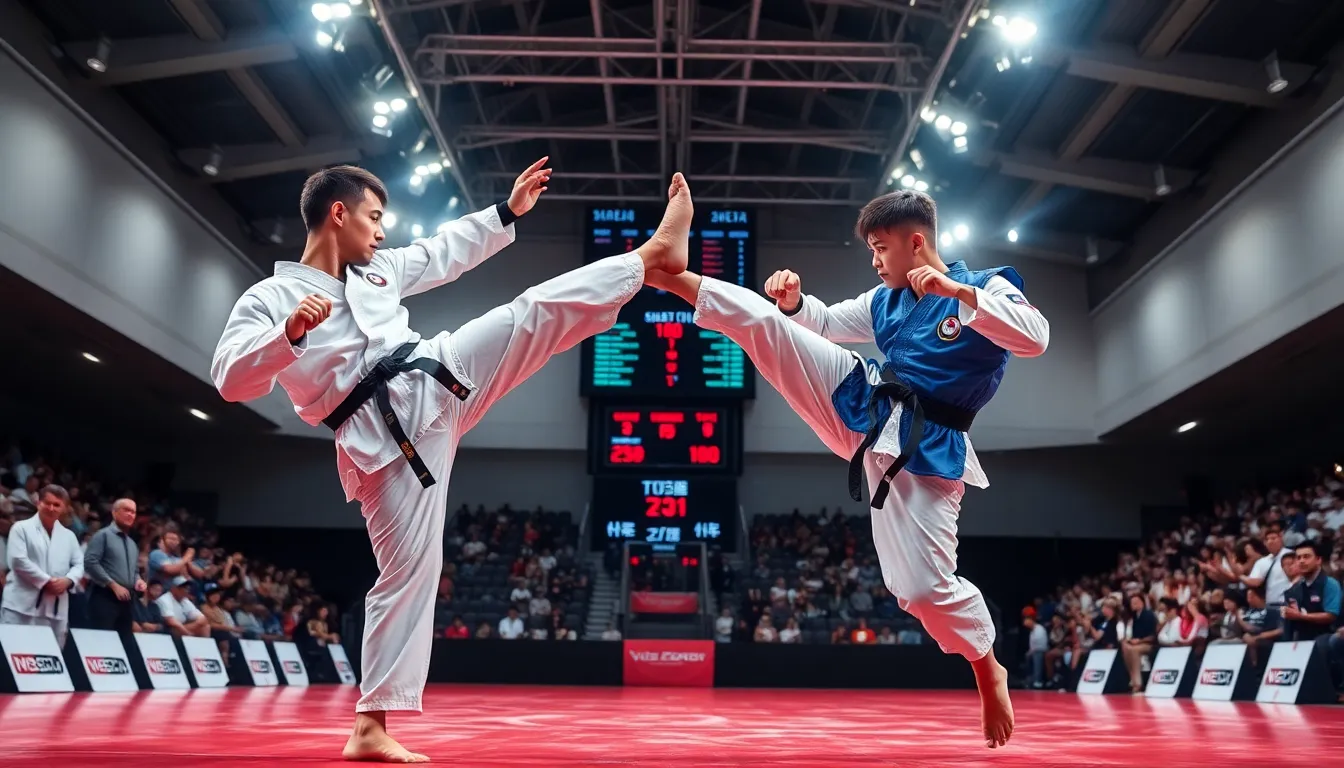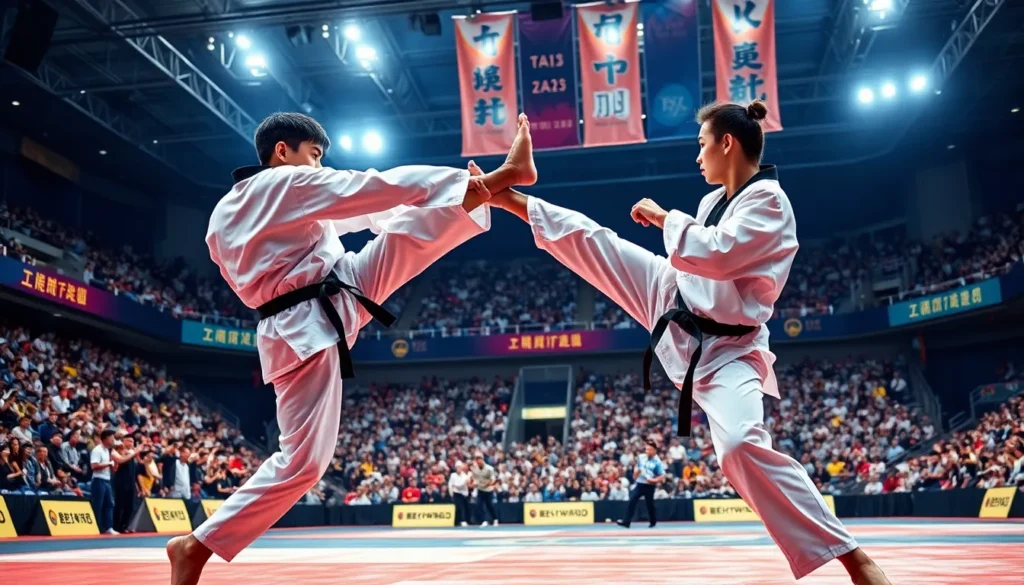Table of Contents
ToggleWhen you think of taekwondo, you might picture high kicks, graceful spins, and a few enthusiastic spectators. But, if you’ve ever pondered just how intense and strategic these bouts can be, you’re in for a treat. Imagine navigating the martial arts landscape where precision meets passion, and all amidst the thrill of a competitive arena. In this comprehensive guide to taekwondo bouts, we’ll not only uncover the different types of competitions but also investigate into rules, trends, and how you can prepare and engage with this martial art like a true aficionado. So grab your dobok and get ready to kick your knowledge into high gear.
Understanding Taekwondo Competitions

Taekwondo competitions are more than just physical contests: they’re a celebration of skill, strategy, and tradition. Practiced worldwide, taekwondo emphasizes both mental and physical discipline, making it a unique form of martial art. Competitions are typically structured in a series of bouts where competitors can showcase their skills. These take place at various levels, from local tournaments to international championships like the Olympics.
Within these events, athletes compete in separate weight divisions to ensure fair play. Each match is composed of three rounds, where fighters earn points through controlled strikes and techniques. The primary goal is not just to outshine an opponent but to embody the spirit of taekwondo, which includes respect, integrity, and perseverance.
Types of Taekwondo Bouts
Taekwondo boasts a range of competitive formats, tailored to different skills and purposes. Here are some key types:
Sparring Bouts
Sparring, or ‘kyorugi,’ is perhaps the most recognized form. Here, competitors face off in an effort to demonstrate their speed and agility, all while attempting to score points by landing accurate strikes on their opponent. Points are awarded based on the technique used and the area struck.
Poomsae Competitions
Plus to sparring, taekwondo includes poomsae competitions, where athletes perform a series of predetermined forms or patterns. Judges evaluate these performances based on precision, technique, and timing. Poomsae focuses on the beauty and fluidity of movements, making it a graceful side of the sport.
Team Events
Some tournaments feature team events, allowing competitors to team up and showcase collective skill. This fosters camaraderie and team spirit, adding a dynamic layer to traditional competitions.
Rules and Regulations of Taekwondo
Understanding the rules of taekwondo is vital for participants and spectators alike. These regulations ensure fairness and safety during competitions. Here are the essential frameworks:
Scoring System
In sparring, points are scored when a competitor lands a decisive blow to their opponent. Judges evaluate the strike’s quality, aiming for controlled contact. The more powerful and technically sound the strike, the higher the score. For instance, a kick to the head earns more points than a punch to the torso.
Protective Gear
Athletes must wear protective gear, including headgear, chest protectors, forearm guards, shin guards, and foot protectors. This equipment is crucial to minimize injuries while allowing participants to showcase their skills effectively.
Violations
Certain actions, like striking below the waist, hitting through excessive force, or executing illegal techniques, can result in penalties. Understanding these rules is key to mastering the game and avoiding disqualification.
So, whether competing or spectating, being aware of these regulations enhances the experience.
The Latest Trends in Taekwondo Bouts
The world of taekwondo is always evolving, with new trends influencing both competitions and training methods. These changes aim to enhance performance, safety, and fan engagement. Some of the latest developments include:
Technology in Training
Modern technology plays a pivotal role in training today. From virtual reality simulations to advanced sports analytics, athletes can better analyze their performance and devise strategies for improvement.
Emphasis on Mental Wellness
Recent trends also highlight the importance of mental health in athletics. Many taekwondo schools are incorporating mindfulness techniques, which benefit competitors in both preparation and competition settings, ensuring that mental clarity meets physical prowess.
Inclusion and Diversity
The sport is increasingly focused on inclusion. Various organizations are promoting equal opportunities, encouraging participation from diverse groups, so enriching the community and enhancing the competitive landscape.
Preparing for a Taekwondo Bout
Preparation is critical for anyone looking to compete in taekwondo. Here are essential steps to ensure you’re ready to shine:
Physical Conditioning
Consistent conditioning is key. This includes strength training, endurance exercises, and flexibility work, aimed at improving overall performance. A well-rounded regimen can significantly enhance fighting capability.
Skill Development
Engaging in regular practice sessions helps refine techniques. Partner sparring and solo drills should focus on improving precision and speed, ensuring that athletes are not just physically fit but also technically proficient.
Strategy and Mindset
Entering a bout with the right mindset can make all the difference. Athletes should visualize potential scenarios and develop a game plan. Mentally rehearsing techniques can help boost confidence and ensure players are match-ready.
How to Watch and Follow Taekwondo Events
For those looking to dive deeper into the world of taekwondo, keeping up with events is essential. Here’s how:
Streaming Platforms
Many notable competitions are available for live viewing on specific streaming platforms. Sites like NBC Sports and various social media channels offer coverage of major tournaments.
Local Clubs and Gyms
Joining a local taekwondo club can provide insights into upcoming competitions. Clubs not only foster a sense of community but often organize fun events where fans can watch and learn.
Social Media Engagement
Following taekwondo organizations on platforms such as Instagram and Twitter keeps enthusiasts informed about new developments, events, and updates in real-time. This immediate access allows fans to engage with the sport and its athletes meaningfully.







